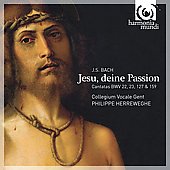What can you say except that Philippe Herreweghe and his Collegium Vocale Gent are the defining interpreters of Bach’s vocal and choral works for our time? This is not just a function of skillful exploitation of modern recording techniques and technology or judicious application of recent scholarship, but largely owes to a particular quality of sound and a unique interpretive sensibility that pervades each performance, informed by this conductor and ensemble’s nearly 40-year collaboration focused predominantly on Bach.
Herreweghe has steered clear of gimmicky “pilgrimages” (à la Gardiner) and avoided the constraints and inevitable artistic compromises of a years’-long “complete-cantata” project–which helps to explain why his work in this repertoire is so reliably, consistently superior, well-thought-out, thoroughly rehearsed, and intelligently cast. Period-instruments are key, but as important is choosing singers technically and timbrally suited for Bach, who also know the German texts (not just how to pronounce them!) so well as to immediately impart their meaning in a personal way.
Happily, Herreweghe and his colleagues recognize and celebrate the joy in Bach’s music as much as they indulge its more solemn, contemplative, and portentous aspects, and in these four extraordinary cantatas we find all of the above in abundance. The fact that each of these works was written for the Sunday before Lent (after which no concerted music would be heard in the church until Good Friday) means that they are essentially Passion-cantatas–and for this Bach seems to have spared nothing in creative resources, especially regarding melodic invention and text-and-mood setting. (“Passion” certainly could apply to the music here in more than its original meaning.) In fact, in these four works, all written for Leipzig, the earliest two being Bach’s “audition” pieces in 1723 for the post of Thomaskantor, we find some of his most affecting and beautiful arias, along with one of his signature extended opening choruses (a kind of mini-preview of the later St. Matthew?).
And speaking of the St. Matthew Passion, listeners familiar with that monumental masterpiece or with the equally (and differently) impressive St. John will find in these four cantatas many familiar musical-stylistic elements prevalent in those works and at which Bach’s compositional skills were unrivalled: the joyful, uplifting dance character of both the aria “Mein alles in allem…” from BWV 22 (perfectly sung by Jan Kobow and expertly accompanied) and the following chorale; the alternate musical embodiment of such emotions and moods as mournfulness (those oboes and violas!), prayerful exhortation, heartfelt pleading–never more affecting than the recitative of BWV 23 (Ah, do not pass me by!), and pure hopefulness and joyful expectation (the following chorus, “The eyes of all, Lord, wait upon thee”).
With remarkable ingenuity–one of his more lovely melodies countered and supported by an equally beautiful instrumental accompaniment–Bach manages in the chorale cantata BWV 159 to combine the gravity and sadness of the text in the bass aria “Es ist vollbracht” (It is finished), taken from Christ’s final words on the cross, with the uplifting hopefulness of its further meaning–that “pain is ended” and we are now “made righteous in God.” There are many other such profoundly artful and prodigiously moving moments, including the soprano aria from BWV 127 (“Die Seele ruht in Jesu Händen”), which certainly is among Bach’s finest creations, and the alto aria from BWV 159, which is sung against a soprano cantus firmus–the text “Ich will hier bei dir stehen”, sung to the famous “Passion Chorale” tune Bach later used extensively in the St. Matthew.
In fact, taken together, and considering their varied music, significant and pertinent textual material, and well-ordered thematic structures, these four cantatas could stand as a sort of passion-oratorio, which is another level on which Herreweghe’s programming should be commended.
As suggested above, virtually all of the soloists, as well as the chorus (which includes the soloists), orchestra, and continuo players, are first-rate–combining complementary timbres with knowing style, refined technique that doesn’t subdue the music’s emotional aspects, and absolutely right tempos. The recording, from the Stolberger Saal in Cologne, matches the high standard of the performances in every way. This is a recording that no lover of Bach’s music should miss. [3/16/2009]
































